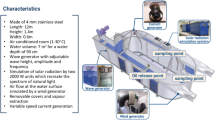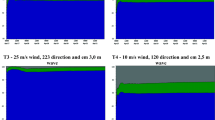Abstract
Successful application of dispersants can reduce oil-spill impacts to wildlife and shoreline habitats, with the tradeoff of dispersed oil potentially causing impacts to water column organisms. Oil-spill fate and transport modeling was used to evaluate the maximum potential water column hydrocarbon concentrations and impacts of oil spills with dispersant use in offshore waters. The model estimated expected concentrations in the surface mixed layer for the largest potential volume of oil that could be dispersed in U.S. waters at any one location and time, that dispersed by a single sortie of a C-130 aircraft assuming a 20:1 oil to dispersant ratio and 80% efficiency (378.5 m3 of light Arabian crude oil). For this oil volume and no dispersant, wildlife impacts would occur on the scale of 100 s km2, whereas upper (<20 m) water column effects with 80% dispersion in one contiguous area would occur on the scale of 1 km2. The model results for these offshore scenarios show that the tradeoff of decreasing wildlife impacts with dispersant use at the expense of possibly increasing water column impacts is supportive of dispersant use. The exceptions would be when sensitive water column biota are present in surface water under the slick and in shallow (<10 m) confined water bodies where dilution would be slower.
Access this chapter
Tax calculation will be finalised at checkout
Purchases are for personal use only
Preview
Unable to display preview. Download preview PDF.
Similar content being viewed by others
References
Al Allen, 2004, Spilltec, Woodinville, WA, personal communication, September 2004.
American Petroleum Institute (API), National Oceanic and Atmospheric Administration (NOAA), U.S. Coast Guard (USCG), and U.S. Environmental Protection Agency (USEPA), 2001, Characteristics of Response Strategies: A Guide for Spill Response Planning in Marine Environments. Joint Publication of API, NOAA, USCG, and USEPA, June 2001.
French McCay, D. and Payne, J.R., 2001, Model of Oil Fate and Water Concentrations with and with out Application of Dispersants, in: Proceedings of the 24th Arctic and Marine Oilspill Program (AMOP) Technical Seminar, pp. 611-645. Emergencies Science Division, Environment Canada, Ottawa, ON,
French, D., Reed, M., Jayko, K., Feng, S., Rines, H., Pavignano, S., Isaji, T., Puckett, S., Keller, A., French III, F.W., Gifford, D., McCue, J., Brown, G., MacDonald, E., Quirk, J., Natzke, S., Bishop, R., Welsh, M., Phillips, M. and Ingram, B.S., 1996, The CERCLA Type A Natural Resource Damage Assessment Model for Coastal and Marine Environments (NRDAM/CME), Technical Documentation, Vol. I-V. Submitted to the Office of Environmental Policy and Compliance, U.S. Department of the Interior, Washington, DC.
French, D.P., Rines, H. and Masciangioli, P., 1997, Validation of an Orimulsion Spill Fates Model Using Observations from Field Test Spills, in: Proceedings of the Twentieth Arctic and Marine Oilspill Program (AMOP) Technical Seminar, pp. 933-961. Emergencies Science Division, Environment Canada, Ottawa, ON.
French McCay, D.P., 2002, Development and Application of an Oil Toxicity and Exposure Model, OilToxEx. Environmental Toxicology and Chemistry. 21(10): 2080-2094.
French McCay, D.P., 2003, Development and Application of Damage Assessment Modeling: Example Assessment for the North Cape Oil Spill. Marine Pollution Bulletin. 47(9-12):341-359.
French McCay, D.P., 2004, Oil Spill Impact Modeling: Development and Validation. Environmental Toxicology and Chemistry. 23(10):2441-2456.
French McCay, D.P., Aurand, D., Michel, J., Unsworth, R., Whittier, N., Lord, C., Dalton, C., Levine, R., Rowe, J., Sankaranarayanan, S., Kim, H.-S., Piovesan, R. and Hitchings, M., 2004, Oil Spills Fate and Effects Modeling for Alternative Response Scenario. Final Report to US Department of Transportation, Cambridge, MA and US Coast Guard, Washington, DC, submitted by Applied Science Associates, Narragansett, RI, USA, 6 volumes.
French McCay, D.P. and Rowe, J.J., 2004, Evaluation of Bird Impacts in Historical Oil Spill Cases Using the SIMAP Oil Spill Model, in: Proceedings of the Twenty-Seventh Arctic and Marine Oil Spill Program (AMOP) Technical Seminar, pp. 421-452. Emergencies Science Division, Environment Canada, Ottawa, ON.
Jokuty, P., Whiticar, S., Wang, Z., Fingas, M., Fieldhouse, B., Lambert, P. and Mullin, J., 1999, Properties of Crude Oils and Oil Products. Manuscript Report EE-165, Environmental Protection Service, Environment Canada, Ottawa, ON, (www. etcentre.org/spills).
National Research Council, 1985, Oil in the Sea: Inputs, Fates and Effects. National Academy Press, Washington, DC.
National Research Council, 2002, Oil in the Sea III: Inputs, Fates and Effects. National Academy Press, Washington, DC.
National Research Council (NRC), 2005, Understanding Oil Spill Dispersants: Efficacy and Effects. National Research Council, Ocean Studies Board, National Academies Press, Washington, DC.
S.L. Ross Environmental Research, 1997, A Review of Dispersant Use on Spills of North Slope crude oil in Prince William Sound and the Gulf of Alaska. Report prepared for Prince William Sound Regional Citizens’ Advisory Council, Anchorage, Alaska.
Thorpe, S.A., 1984, On the Determination of Kv in the Near Surface Ocean from Acoustic Measurements of Bubbles. American Meteorological Society: 861-863.
U.S. Coast Guard (USCG), 1999, Response Plan Equipment Caps Review: Are Changes to Current Mechanical Recovery, Dispersant, and in situ Burn Equipment Requirements Practicable? United States Coast Guard, U.S. Department of Transportation, Washington, DC.
U.S. Coast Guard (USCG), 2004, Draft Programmatic Environmental Impact Statement (PEIS) for Mechanical Recovery and Alternative Removal Technologies. U.S. Department of Homeland Security, U.S. Coast Guard, Washington, DC.
Youssef, M. and Spaulding, M.L., 1993, Drift Current Under the Action of Wind Waves, in: Proceedings of the Sixteenth Arctic and Marine Oilspill Program Technical Seminar, pp. 587-615. Ottawa, ON, Canada.
Youssef, M. and Spaulding, M.L., 1994, Drift Current Under the Combined Action of Wind and Waves in Shallow Water, in: Proceedings of the Seventeenth Arctic and Marine Oilspill Program (AMOP) Technical Seminar, pp. 767-784. Ottawa, ON, Canada.
Author information
Authors and Affiliations
Corresponding author
Editor information
Editors and Affiliations
Rights and permissions
Copyright information
© 2008 Springer Science + Business Media B.V
About this paper
Cite this paper
French-Mccay, D., Nordhausen, W., Payne, J.R. (2008). Modeling Impacts and Tradeoffs of Dispersant Use on Oil Spills. In: Davidson, W.F., Lee, K., Cogswell, A. (eds) Oil Spill Response: A Global Perspective. NATO Science for Peace and Security Series C: Environmental Security. Springer, Dordrecht. https://doi.org/10.1007/978-1-4020-8565-9_39
Download citation
DOI: https://doi.org/10.1007/978-1-4020-8565-9_39
Publisher Name: Springer, Dordrecht
Print ISBN: 978-1-4020-8564-2
Online ISBN: 978-1-4020-8565-9
eBook Packages: Earth and Environmental ScienceEarth and Environmental Science (R0)




